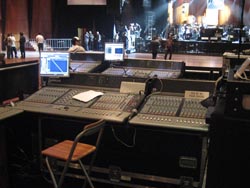Sweet (Sounding) 16

- Stravinsky auditorium was equipped with a Digidesign Profile, which engineers could plug their setting directly into with a USB key.MONTREUX, SWITZERLAND--Every July, a small resort town on picturesque Lake Geneva becomes the site of one of the oldest music festivals in the world. Montreux is a sleepy town the rest of the year, but when the festival hits the population almost doubles in anticipation of the artists that will pass through during the 16-day lineup. While the festival was founded primarily as jazz centric, the founder, Claude Nobs, has opened it to a wide array of genres in recent years.
- The 41st Montreux Jazz Festival featured acts as diverse as Chick Corea to the Beastie Boys. The venue this year was confined to a single building, a departure from recent years where one of the main stages was in the nearby Casino, the original venue for the festival. The new building featured a large main stage, the Stravinsky Auditorium, and the more intimate Miles Davis Hall. The festival also featured several smaller stages within the ground, including the Jazz Cafe, a dance club, a lounge stage, a large outside stage, and several smaller shows on boats touring the lake.
- For the two main halls, similar gear was provided that would allow engineers to customize their setups without taking up too much soundcheck time. The Stravinsky Auditorium was fitted with Meyer Sound's Milo arrays for the main system, as well as M1Ds and Micas for front and center fills respectively. The system also featured twelve Meyer 700-HP subwoofers. For monitors, 10 Meyer UM1-Ps, four USM1-Ps, four MJF-212s, two UPA-1p drum fills, a USW-1P subwoofer drum fill, and eight M'elodie line array side fills were used. The Stravinsky Auditorium is a large hall with a single balcony that was designed to be a classical hall for orchestras, which boasts a reverb time of three seconds. While that might be fine for a symphony, it's hardly necessary for a rock or jazz band. To remedy this, the festival team went to the acoustical designer of the hall to figure out how to cancel out his work. Sound coordinator for the festival, Niveau 2's Pierre-Audr Aebischer, explained, "We had to take the three seconds down to one second or so. The festival crew looks after that during the preloading. There are about 300 acoustical tabs that were designed. The ideal situation would be to have a physical acoustic modulator. Or in an ideal future we'd have a constellation system in there. But that's more of a dream. So about 30 years ago, these hanging baffles were designed. He had to figure out how to undo his own acoustical treatment." Several rows of the baffles are lined across the whole auditorium, as well as several above the stage and attached to the walls.
- Miles Davis Hall featured a Meyer Mica system for main fills, and a CQ-1 for center fill, as well as eight 700-HP subwoofers. For monitors six Um1-Ps, four USM1-Ps, six MJF-212, two 650-P subwoofer side fills, two UPA-1P drum fills, a USW-1P subwoofer drum fill, and two MSL-4 side fills. Each system was optimized with Meyer's Galileo speaker management system. Both auditoriums were also fitted with a TC Electronics REVERB 6000, a Yamaha SPX2000, TC D2 tap delay, Avalon AD2044, and a couple Avalon VT737s.
- Consoles for the festival were all Digidesign VENUEs. In the main halls D-Shows were used, in some of the smaller stages the Profile was employed. Stravinsky featured a 96 channel D-Show, while Miles Davis Hall housed a 48 channel D-Show and the Jazz Caf contained a 48 channel Profile. Digidesign had a room backstage that housed a D-Show, encouraging artists' engineers to plug their settings into the console and familiarize themselves with the surface. Wilco's FOH engineer, Stan Doty, commented on the board situation, "As a sound guy you should be able to go with whatever is offered, especially at festivals. You need to be as transparent as possible so the band isn't worried about you."
This building held the majority of the stages for the 41st Montreux Jazz Festival, including Stravinsky Auditorium and Miles Davis Hall.
Niveau 2 has worked with the festival for years and is charged with putting the sound together. The company coordinates with local rental companies and sponsors to arrange the gear. Aebischer said, "We have a system designer and he communicates with Meyer about changes in the venue and any acoustic changes. And then they coordinate with Digidesign according to the venue needs and whatever the rental companies can provide or what the manufactures provide. During the year we distribute Meyer and Digidesign, so we're in the position to know who can provide the gear, and we know the festival and its people very well."
Digidesign's market manager for live sound products, Robert Scovill, explained, Another important part of the set up is the broadcast trucks that are buried in a garage within the building. The sound from each show, as well as the video from the constantly roving cameras, are all relayed to these trucks and mixed live for broadcast, as well as archiving for future DVDs. Digidesign consoles are in both sound trucks, a 48 channel D-Show for the Miles Davis Hall feed and a 96 channel D-Show for the Stravinsky Auditorium feed. The shows are all recorded to Protools HD systems, and its plugins are used for live mixing as well as post-production. The festival is one of the best documented of its kind and was also the site of the first high definition recording.
A daily selection of the top stories for AV integrators, resellers and consultants. Sign up below.
